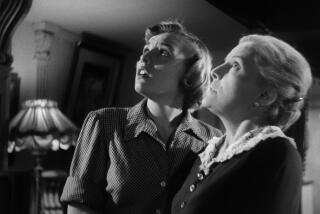James Stewart: Celebrating his 100th birthday
TO MILLIONS, James Stewart was Everyman. To Kelly Stewart, he was just Dad.
“Dad was a very private person,” she says, adding that her father never brought his work home with him. But she got her first inkling of his tremendous popularity at age 6, when she accompanied him to a charity event at the Akron Soap Box Derby.
“I remember seeing these crowds of people, thousands and thousands of people, and police standing in a line to keep the crowds back. They were yelling ‘Jimmy! Jimmy!’ I remember thinking all of these people know Dad’s name. That is when I first realized he was famous.”
The lanky Stewart, who hailed from the Pennsylvania town of Indiana, would have turned 100 this week -- he died at 89 in 1997. And both the UCLA Film & Television Archive and the Academy of Motion Picture Arts and Sciences are celebrating his centenary this month.
UCLA will kick off its film festival “The Picture Starts in Heaven: James Stewart’s Centennial” on Friday at the Billy Wilder Theater with the 1938 comedy “Vivacious Lady” and 1936’s musical “Born to Dance,” in which he warbles “Easy to Love.” The festival also features perhaps his most enduring film, the 1946 holiday classic “It’s a Wonderful Life.”
On June 12, the academy will present “A Centennial Tribute to James Stewart” at the Samuel Goldwyn Theater, which will feature clips and memories with Stewart’s daughters, Kelly and Judy, and such co-workers as Shirley Jones, who appeared with the Oscar winner in the 1961 John Ford western “Two Rode Together” and the 1970 western comedy “The Cheyenne Social Club,” with Henry Fonda.
“I can’t say enough about him,” Jones says. “To watch him and Henry Fonda do a scene together. . . . I have said I often wished I had an acting class come in and watch that, because what they did, and what acting is supposed to be, is that they just talked to each other. A lot of the times they would forget their lines and would just [ad-lib] and talk to each other.”
Stewart, she adds, “was giving as a person and as an actor. He had a great sense of humor and was easy to talk to.”
Perhaps no other actor went through such an evolution on screen as Stewart.
“I think when he came out to Hollywood, the studios didn’t know what to do with him,” says Andrea Alsberg, UCLA’s co-head of exhibition and public programs. “It wasn’t until Frank Capra got ahold of him” -- in 1939’s “Mr. Smith Goes to Washington” -- “that he developed that [everyman] image that we think of him.”
But after his five years in the Army Air Corps during World War II, Stewart returned to Hollywood a changed man. “He did see combat,” Alsberg says. “He matured quickly in those five years.”
And his film roles reflected that newfound maturity -- he helped create dark, complex, often erotic characters for director Alfred Hitchcock in such films as “Vertigo,” which screens May 31, and sagebrush antiheroes in a series of westerns for Anthony Mann, including “The Naked Spur.”
“I think his postwar films and his characters in them are all the more interesting because of his earlier work,” Alsberg says. “If he wasn’t the common man [before the war], he couldn’t have been the uncommon man as easily. And the fact was, he was a really good actor.”
JAMES STEWART CENTENNIAL WHERE: Billy Wilder Theater, 10899 Wilshire Blvd., Westwood; and the Samuel Goldwyn Theater, 8949 Wilshire Blvd., Beverly HillsWHEN: 7:30 p.m. Fri., through June 8 at the Wilder; June 12 at the GoldwynPRICE: $7-$9 at the Wilder; $3-$5 at the GoldwynINFO:www.cinema.ucla.edu, oscars.org







